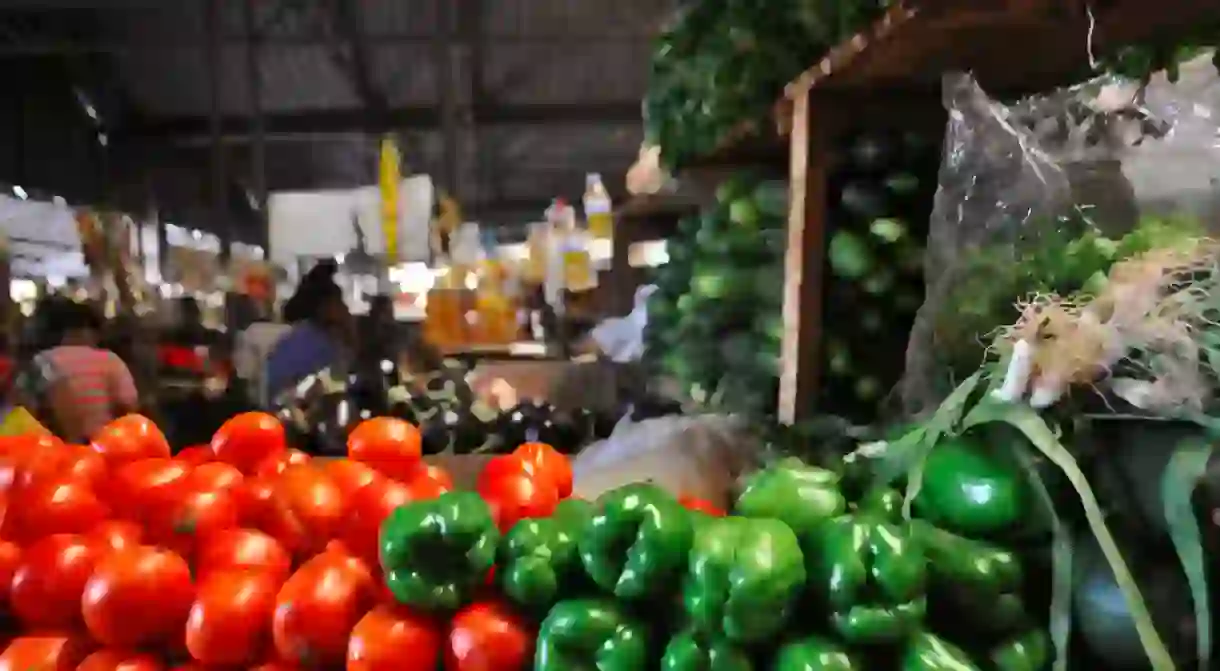An Essential Guide to Kimironko Market in Kigali

East Africa is known for its buzzing, colorful, and distinctive markets, and Rwanda is no exception. Kimironko Market, located in the Kimironko neighborhood of Kigali, is the busiest market in town. Vendors here sell produce from Rwanda, Uganda, Kenya, and the Democratic Republic of Congo, while locals from all over the city head here to stock up on fruit, vegetables, fabric, clothing, shoes, and general household necessities. This is the place to experience Rwanda at its liveliest.

The vivid Kimironko Market is housed in a large warehouse complex, with four equidistant entrances. With your back towards the Kimironko bus station, the official entrance to the market, where household goods and plastic buckets of every shape and size are sold, awaits. The entrance on the right hand side of the market is where the vibrant kitenge fabric is located, and the entrance to the left is where the butchers and fishermen hawk meat and lake fish. The far entrance leads directly to used clothes and the market seamstresses.

Kimironko Market is busiest in the early afternoon, as vendors are just arriving and displaying their items to sell in mid-morning. Open from approximately 8am to 7pm daily, Saturdays and Mondays are often the busiest days of the week, with Sundays considered to be fairly slow with many vendors taking the day off. Getting to and from Kimironko is simple, as the the Kimironko bus park serves most public transit locations in Kigali. Buses from all over the city deliver eager shoppers to the market gates, and motorcycle taxis and regular taxis wait for overloaded shoppers to hire them for a lift back home.

Entering through the front market gates, directly opposite the bus park, veer right and head towards the far market walls. In that area, rows and rows of radiant kitenge fabric are hawked in stalls from all over Africa. Sierra Leone, Nigeria, the Democratic Republic of Congo, Tanzania, Cote D’Ivoire, and many more nations are represented here. This fabric is traditionally sold by women, and if you purchase any, the sellers will likely recommend you to a seamstress located on the outer rim of the kitenge section. These talented tailors are always ready and willing to make quick and affordable kitenge clothing or accessories. Don’t forget that prices are negotiable throughout the market, and while bargaining, stay patient, calm, and steady in order to end up with the best deals.

From the Kitenge stalls and seamstresses, cut a (mostly) straight path aiming for the far left corner of the market. Used clothing, tourist items (stop here for a basket or two!), shoes, and a veritable hardware store are compressed in the small alleyways, before the market opens up into a wide-spread fresh produce emporium.

Endless potatoes, still caked in earth, are piled high in black stalls. Carrots, peppers, tomatoes, zucchini, and eggplant are neatly stacked, making shopping a delicate art form. Juicy mangoes, small bananas, tart passion fruit, and tree tomatoes are sorted on the opposite end of the complex, with avocados the size of your fist holding court somewhere in between. Melons and pumpkins from Uganda are brought it by the truck load, and huge green plantains – still on the branch – line the aisles.

At the front end of the market, towards the bus terminal, oil, spices, garlic, and fresh ginger are sold in organized piles, and the egg section holds court in the left hand corner. The woman who sells eggs is a delight, and has been working at the market for many years. Eggs are brought from all over the city and surrounds, with different prices according to the location of the chicken and the size of the egg. A single egg will cost between 70 and 110 Rwandan francs, or, at the time of publishing, between $0.08 USD and $0.13 USD.

Then, the meat section. Frozen fish lines the left side of the entrance wall, with dried tilapia and isambaza located just across the path and near stacks of leafy green vegetables. The butchers wear white doctors robes, and brandish knives with practiced authority. If you tire of roaming the narrow market corridors and busy aisles, head outside the gates and pop into one of the surrounding restaurants for a quick samosa, chapati, and cold soda.

Though the market is not small by any means, it is easy to navigate, as the items sold are distinctly classified by category and thus location. Kimironko Market – with its array of sights, smells, and sounds – can be understandably overwhelming, but it is still absolutely a must-see in Kigali.













